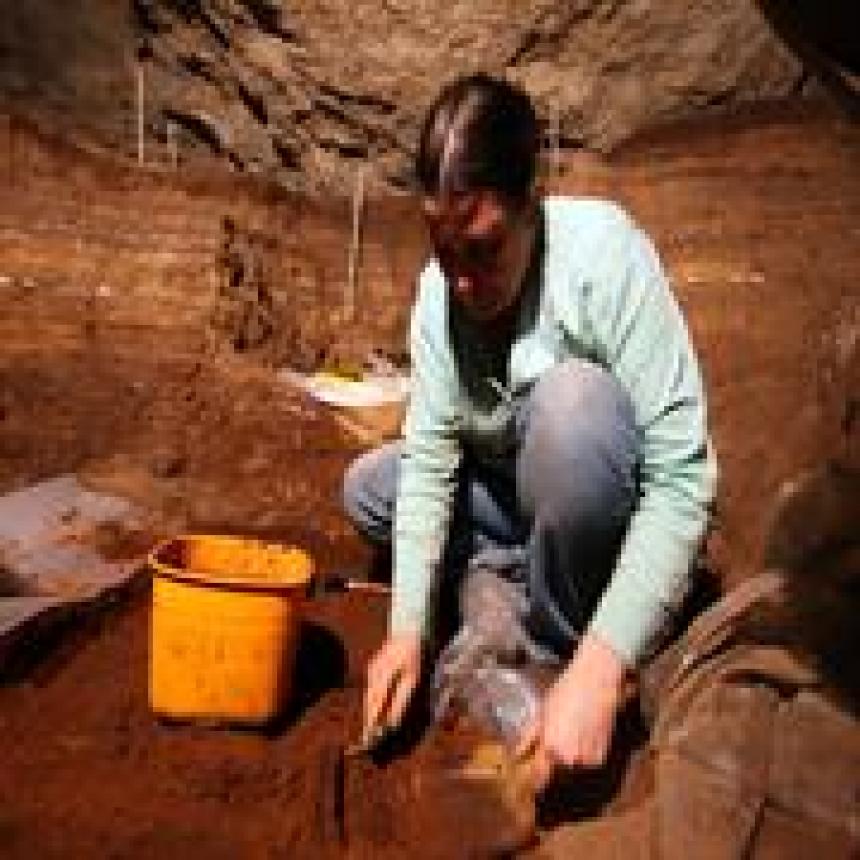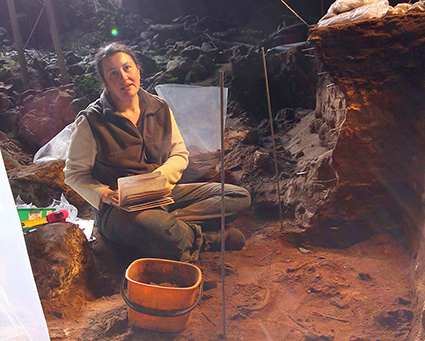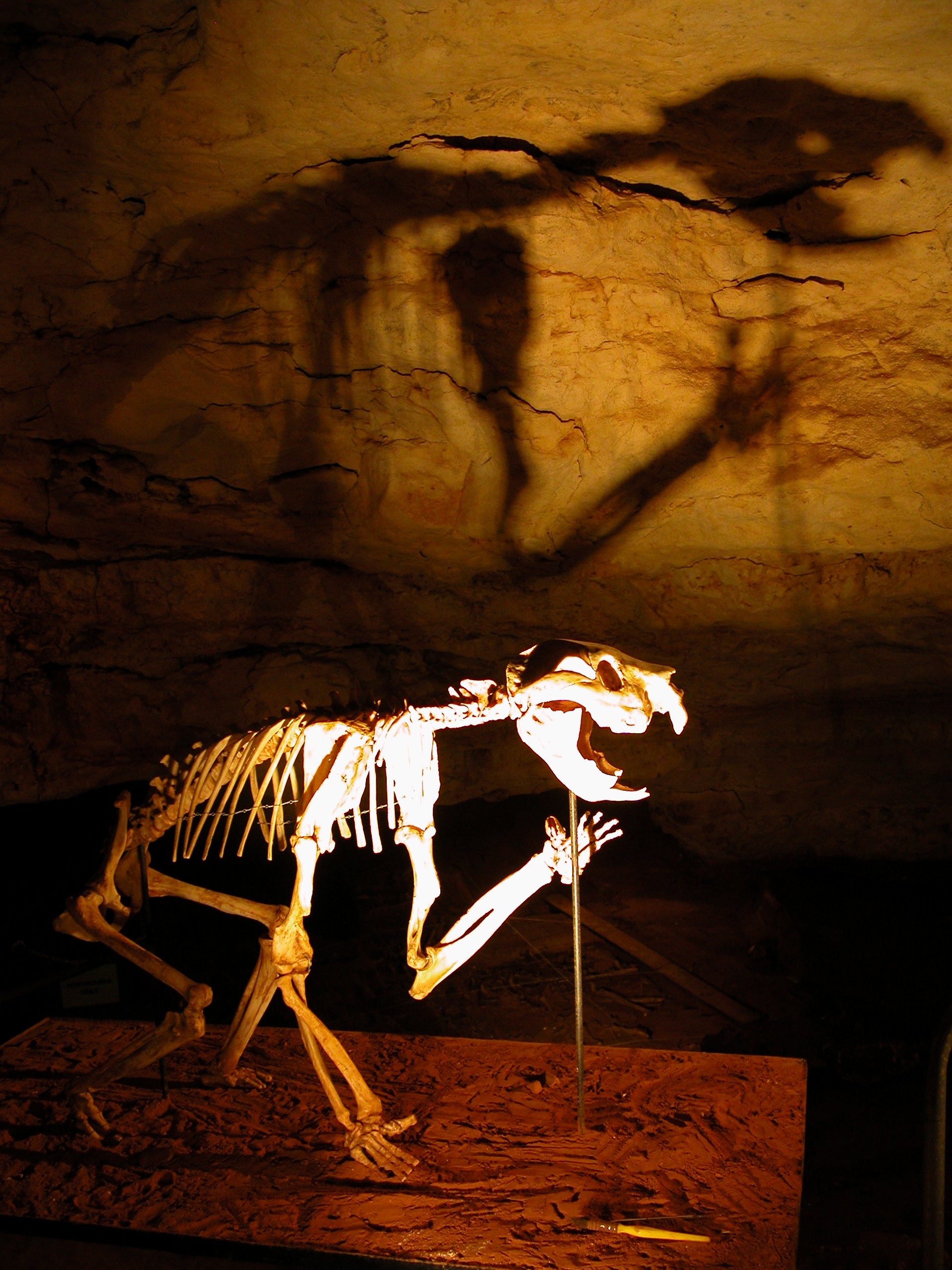
Research Interests
Heritage and Cultural Conservation Palaeoecology Palaeontology Quaternary EnvironmentsDr Liz Reed
Senior Lecturer
School of Biological Sciences
College of Science
I am a vertebrate palaeontologist specialising in Quaternary cave deposits, notably in the south east region of South Australia. My particular interests are vertebrate taphonomy and site history, Quaternary palaeoclimate, biodiversity records from caves and refining megafauna extinction records.I am a Senior Lecturer within the Department of Ecology and Evolutionary Biology in the School of Biological Sciences and a member of the Environment Institute.I completed an Honours degree in vertebrate palaeontology at Flinders University, studying how kangaroo skeletons decompose and disarticulate in a natural environment. I was awarded my PhD in 2004. My thesis research involved taphonomic (fossil forensics) studies of large mammal fossils from the Pleistocene-aged deposits within the World Heritage listed Naracoorte Caves National Park. Since then I have taught at undergraduate and graduate level and continue to study cave deposits in the South East region of South Australia.
My current research projects centre on Quaternary aged vertebrate fossil deposits from caves in the Naracoorte area of the Limestone Coast region of South Australia. In collaboration with colleagues from University of Adelaide's Environment Institute and various institutions in Australia and overseas, I am working on refining the age and palaeoenvironmental context of key deposits at Naracoorte.
Current projects -:
- Refining the chronology and environmental context of megafauna extinctions at Naracoorte.
- Palaeontology and taphonomy of Naracoorte fossil assemblages.
- Investigation of cave deposits found in limestone quarries at Naracoorte.
- Review of fossil faunas including megafauna marsupials, bats, frogs and reptiles.
I am a member of the Environment Institute and Sprigg Geobiology Centre at University of Adelaide. I am also a Research Associate with the South Australian Museum.
I was named Unsung Hero of Science Communication for 2018 at the South Australian Science Excellence Awards.
Our latest article in The Conversation.
The Environment Institute Annual Report 2015 features a great story about research at Naracoorte Caves.
Check out the July 2015 issue of e-Science magazine to see my article on the fossils of Naracoorte. http://escience.realviewdigital.com/?iid=122820#folio=24
Don't forget to visit the amazing Naracoorte Caves!
Below - Digging for megafauna, Naracoorte Caves National Park. During the Pleistocene, megafauna and other animals fell into caves and became trapped with their remains accumulating in the cave below. Over time these remains were buried by sediments that washed or blew into the cave. Fossil bones are delicate, so we use small dental picks and brushes to expose the long buried fossils. The position of each bone is recorded in detail and samples of charcoal, bone, sediment and cave formations (speleothems) are used to determine the age of the deposits. Photo Steve Bourne.

Below - Peeling back the layers in time - Liz Reed excavating in Blanche Cave (Naracoorte Caves National Park), assisted by Cath Loder. The finely layered strata are visible in the sandy cave sediments. Each layer represents a period of time. Like chapters in a book each has a story to tell about the past animals and environment at Naracoorte. Photo Steve Bourne.

Below - One of the many exceptionally well preserved fossils from Naracoorte Caves. This is the skull of an extinct short-faced kangaroo. The fossil caves of the Naracoorte Caves National Park are deemed so signficant that they are World Heritage listed. Much of my research centres on these deposits. Photo Steve Bourne.

Below - A tiny fossil bat dentary from the late Pleistocene of Naracoorte. Bats have lived in caves at Naracoorte for hundreds of thousands of years. Their fossil remains accumulated from natural deaths beneath roosts in the caves. Other small vertebrates such as rodents and dasyurids fell victim to owl predation, forming large accumulations derived from owl pellets. Photo Liz Reed

| Date | Position | Institution name |
|---|---|---|
| 2019 - ongoing | Lecturer in palaeontology | University of Adelaide |
| 2015 - 2018 | Research Fellow | University of Adelaide |
| 2011 - 2013 | Research Fellow, vertebrate palaeontology | Flinders University |
| 2006 - 2010 | Lecturer in palaeontology | Flinders University |
| Date | Institution name | Country | Title |
|---|---|---|---|
| 2005 | Deakin University | Australia | Grad. Cert. Museum Studies |
| 2004 | Flinders University | Australia | PhD |
| 1997 | Flinders University | Australia | BA (Hons) |
| Year | Citation |
|---|---|
| 2023 | Webb, J., White, S., & Smith, G. K. (Eds.) (2023). Australian Caves and Karst Systems. Springer International Publishing. DOI |
| 2006 | Reed, E. H., Bourne, S., Megirian, D., Prideaux, G., & Young, G. (Eds.) (2006). Proceedings of the 10th Conference on Australasian Vertebrate Evolution, Palaeontology and Systematics. Alcheringa Special Issue 1.. |
| Year | Citation |
|---|---|
| 2023 | Reed, E. (2023). Vertebrate Fossils in Australian Caves: Underground Archives of Past Biodiversity. In J. Webb, S. White, & G. Smith (Eds.), Australian Caves and Karst Systems (1 ed., pp. 297-312). Springer. DOI |
| 2012 | Reed, E. H. (2012). South Australia: Naracoorte Caves. In Australian Heritage Council (Ed.), Australia’s Fossil Heritage: a catalogue of important Australian fossil sites (pp. 69-70). |
| 2012 | Reed, E. H. (2012). South Australia: Naracoorte Caves. In Australian Heritage Council (Ed.), Australia’s Fossil Heritage: a catalogue of important Australian fossil sites (pp. 69-70). |
| 2009 | Reed, E. H. (2009). A vertebrate CSI. In South Australian Museum (Ed.), The Fossil Hunters (pp. 37-41). Adelaide: South Australian Museum. |
| 2003 | Reed, E. H., & Gillieson, D. (2003). Mud and bones: cave deposits and environmental history in Australia.. In B. Finlayson, & E. Hamilton-Smith (Eds.), Beneath the surface: a natural history of Australian Caves (pp. 89-110). Sydney: University of New South Wales Press. |
| Year | Citation |
|---|---|
| 2019 | Reed, E. H. (2019). Naracoorte Caves: a critical window on faunal extinctions and past climates. In Proceedings of the 31st Biennial Conference of the Australian Speleological Federation (pp. 12-19). Devonport, Australia: Australian Speleological Federation. |
| Year | Citation |
|---|---|
| 2021 | Weij, R., Woodhead, J., Reed, E., Sniderman, K., Hellstrom, J., & Drysdale, R. (2021). The World Heritage Naracoorte Caves beyond 500 ka: U-Pb dating and charcoal analysis from speleothems with implications for Pleistocene vertebrate fossil deposits. Poster session presented at the meeting of Abstracts of the EGU General Assembly 2021. virtual online: Copernicus GmbH. DOI |
| 2018 | Weij, R., Woodhead, J., Hellstrom, J., Sniderman, K., Reed, E. H., Drysdale, R., & Bajo, P. (2018). Speleothem rubble as a new low-impact tool for cave-based palaeoclimate studies. Poster session presented at the meeting of European Geosciences Union General Assembly 2018. Vienna, Austria. |
| 2017 | Reed, E. (2017). The contribution of cave sites to the understanding of Quaternary Australian megafauna records. Poster session presented at the meeting of Proceedings of the 17th International Congress of Speleology, Volume 1 Edition 2. Sydney: Australian Speleological Federation Inc and Speleo2017 in the co-operation with the International Union of Speleology.. |
| 2016 | Gray, J., Reed, E. H., Hutchinson, M., Jones, M., & McDowell, M. (2016). Agamid lizard fossils from South Australian caves and their implications for environmental change during the Quaternary. Poster session presented at the meeting of Geological Society of Australia Abstracts. Hornsby, NSW: Geological Society of Australia. |
| 2016 | Reed, E. H., & Reardon, T. (2016). Fossil bats from Quaternary cave deposits at Naracoorte, South Australia.. Poster session presented at the meeting of Geological Society of Australia Abstracts. Hornsby, NSW: Geological Society of Australia. |
| 2015 | Gray, J., Reed., & McDowell, M. (2015). Agamid (Reptilia: Squamata) assemblages from South Australia suggest differences between Pleistocene and modern distributions that reflect climate change. Poster session presented at the meeting of Society of Vertebrate Paleontology annual meeting. Dallas, Texas, USA. |
| 2015 | Gray, J., Reed., & McDowell, M. (2015). Agamid (Reptilia: Squamata) assemblages from South Australia suggest differences between Pleistocene and modern distributions that reflect climate change. Poster session presented at the meeting of Society of Vertebrate Paleontology annual meeting. Dallas, Texas, USA. |
| 2015 | Reed, E. H. (2015). Priests, parties and palaeontologists: a potted history of the Naracoorte Caves.. Poster session presented at the meeting of Reflections: The 22nd State History Conference. Robe, South Australia. |
| 2015 | Reed, E. H. (2015). Site formation processes and their influence on chronological records from cave deposits: examples from Naracoorte Caves. Poster session presented at the meeting of 4th Asia Pacific Luminescence and Electron Spin Resonance Dating Conference. University of Adelaide. |
| 2006 | Reed, E. H., Wells, R., Bourne, S., & Sellar, A. (2006). Discovering the history of life on Earth in South Australia. Poster session presented at the meeting of Alcheringa Special Issue 1. Naracoorte, SA. |
| 2006 | Reed, E. H., Wells, R., Bourne, S., & Sellar, A. (2006). Discovering the history of life on Earth in South Australia. Poster session presented at the meeting of Alcheringa Special Issue 1. Naracoorte, SA. |
| 2006 | Reed, E. H. (2006). A modern taphonomic analogue for Pleistocene pitfall cave deposits at Naracoorte, South Australia.. Poster session presented at the meeting of Alcheringa Special Issue 1. Naracoorte SA. |
| 2006 | Reed, E. H. (2006). A modern taphonomic analogue for Pleistocene pitfall cave deposits at Naracoorte, South Australia.. Poster session presented at the meeting of Alcheringa Special Issue 1. Naracoorte SA. |
| 2006 | Wells, R., Grun, R., Forbes, M., Sullivan, J., Bestland, E., & Reed, E. H. (2006). The Black Creek Swamp Megafauna Site, Kangaroo Island: pre or post blitzkreig?. Poster session presented at the meeting of Alcheringa Special Issue 1. Naracoorte SA. |
| 2006 | Wells, R., Grun, R., Forbes, M., Sullivan, J., Bestland, E., & Reed, E. H. (2006). The Black Creek Swamp Megafauna Site, Kangaroo Island: pre or post blitzkreig?. Poster session presented at the meeting of Alcheringa Special Issue 1. Naracoorte SA. |
| 2006 | ABSTRACTS FROM CAVEPS 2005 (2006). Poster session presented at the meeting of Alcheringa: An Australasian Journal of Palaeontology. Informa UK Limited. DOI |
| 2006 | Sullivan, J., Wells, R., Reed, E. H., Forbes, M., & Bestland, E. (2006). A taphonomic investigation of the Black Creek Swamp megafaunal accumulation.. Poster session presented at the meeting of Alcheringa: an Australian journal of palaeontology. Naracoorte: Taylor & Francis. DOI |
| 1999 | Reed, E. H. (1999). A taphonomic study of the disarticulation of macropodid skeletons in a semi-arid environment.. Poster session presented at the meeting of Records of the Western Australian Museum Supplement No. 57 01/1999. Perth, Australia. |
| Year | Citation |
|---|---|
| 2003 | Reed, E. H. (2003). Draft fossil-based tourism scoping study.. |
| Year | Citation |
|---|---|
| 2003 | Reed, E. H. (2003). Vertebrate Taphonomy of large mammal bone deposits, Naracoorte Caves World Heritage Area.. (PhD Thesis, Flinders University). |
| Year | Citation |
|---|---|
| 2017 | Reed, E. H., & Arnold, L. (2017). Naracoorte, where half a million years of biodiversity and climate history are trapped in caves. The Conversation. |
| 2015 | Reed, E. H. (2015). Underground archives: Naracoorte's fossil caves and their record of deep time.. University of Adelaide. |
| Year | Citation |
|---|---|
| 2024 | Beasley-Hall, P., Trewick, S., Eberhard, S., Zwick, A., Reed, E., Cooper, S., & Austin, A. (2024). Molecular phylogenetics illuminates the evolutionary history and hidden diversity of Australian cave crickets (Orthoptera: Rhaphidophoridae). DOI |
- 2024 Australian Research Council Linkage Project Linkage project scheme Fordham DA, Wood J, Austin JA, Reed E, Helgen K Preventing extinctions of threatened mammals with DNA in sediment archives $670, 000 (2025-2028)
- 2022 Australian Research Council Linkage Project Scheme. LP21020070. Louys J, Arnold LJ, Demuro M, Reed E, Moss P, Price GJ, Duval M, Wolf P. Deep time extinctions and environments in Australian underwater caves. $260,820.
- 2021 Australian Government, Australian Heritage Grants 2020-21. AJG111000084 Natural values assessment and conservation monitoring of Naracoorte Caves. $189,869.
- 2018 Australian Nuclear Science and Technology Organisation (ANSTO) Research Portal grant - proposal 11688. Reconstructing Quaternary climate sequence at Alexandra Cave using single-grain OSL dating and environmental proxies. Priya, P. Gadd, J. Tibby, L.J. Arnold, E. Reed, M. Demuro.
- 2017 Australian Research Council Linkage Project Scheme. LP160101249 Dr Lee Arnold, Prof. Bob Hill, Dr Elizabeth Reed, Prof. Alan Cooper, Assoc. Prof. Jeremy Austin, Dr John Tibby, Associate Professor Russell Drysdale; Dr John Hellstrom; Dr Gilbert Price; Dr Helen Macdonald; Dr Daniel Rogers; Dr Mark Hutchinson; Adjunct Professor Nigel Spooner. Naracoorte caves: a critical window on faunal extinctions and past climates. $669,000.
- 2017 Babara Kidman Women's Fellowship, Dr Elizabeth Reed, University of Adelaide. $20,000.
- 2016 DVCR Interdisciplinary Research Grants University of Adelaide - Dr Elizabeth Reed, Professor Alan Cooper, Dr Lee Arnold, Dr John Tibby, Professor Nigel Spooner. Preliminary investigation of Quaternary vertebrate fossil sites from caves in central and northwest Tasmania: testing a multi-proxy approach for reconstructing past biodiversity and environment. $23,600.
- 2015 Environment Institute grant - Refining the timing and palaeoenvironmental context for megafauna extinction records at Naracoorte, South Australia. EI Investigators – Dr Liz Reed (CI), Dr Lee Arnold, Dr Francesca McInerney, Dr John Tibby, Dr Jonathan Tyler and Dr Juraj Farkas. $50,000.
My current undergraduate teaching:
PALAEO3500 Field Palaeontology - teacher
PALAEO3005 Geochronology, Fossils and Palaeoenvironments III - teacher
ENVBIOL3590 Evolutionary Biology III - Coordinator and teacher
Below - The reconstructed skeleton of Thylacoleo carnifex looms large over the fossil bed in Victoria Fossil Cave, Naracoorte Caves NP. Photo Steve Bourne

| Date | Role | Research Topic | Program | Degree Type | Student Load | Student Name |
|---|---|---|---|---|---|---|
| 2024 | Co-Supervisor | Shaping palaeoherpetology in Australia: a spatial and temporal view of the palaeoecology of Varanus. | Doctor of Philosophy | Doctorate | Full Time | Miss Isabella Donato |
| 2024 | Co-Supervisor | A phenotypic and genetic approach to identify fossil frogs from Naracoorte caves with comparison to modern Australian species in the southeast. | Doctor of Philosophy | Doctorate | Full Time | Miss Natasha Lee Hiotis |
| 2024 | Co-Supervisor | Shaping palaeoherpetology in Australia: a spatial and temporal view of the palaeoecology of Varanus. | Doctor of Philosophy | Doctorate | Full Time | Miss Isabella Donato |
| 2024 | Co-Supervisor | A phenotypic and genetic approach to identify fossil frogs from Naracoorte caves with comparison to modern Australian species in the southeast. | Doctor of Philosophy | Doctorate | Full Time | Miss Natasha Lee Hiotis |
| 2022 | Co-Supervisor | Miocene marine fossils of southern Australia | Doctor of Philosophy | Doctorate | Full Time | Miss Mahala Ann Fergusen |
| 2022 | Co-Supervisor | Miocene marine fossils of southern Australia | Doctor of Philosophy | Doctorate | Full Time | Miss Mahala Ann Fergusen |
| 2021 | Co-Supervisor | Examining Fossil Preservation Histories at the UNESCO World Heritage Naracoorte Caves National Park | Doctor of Philosophy | Doctorate | Full Time | Mr Andrew Jeremy Chua |
| 2021 | Co-Supervisor | Examining Fossil Preservation Histories at the UNESCO World Heritage Naracoorte Caves National Park | Doctor of Philosophy | Doctorate | Full Time | Mr Andrew Jeremy Chua |
| 2016 | Principal Supervisor | Palaeoecology of vertebrates of the Late Quaternary from the Naracoort Caves fossil deposits | Doctor of Philosophy | Doctorate | Part Time | Miss Jessie-Briar Treloar |
| 2016 | Principal Supervisor | Palaeoecology of vertebrates of the Late Quaternary from the Naracoort Caves fossil deposits | Doctor of Philosophy | Doctorate | Full Time | Miss Jessie-Briar Treloar |
| Date | Role | Research Topic | Program | Degree Type | Student Load | Student Name |
|---|---|---|---|---|---|---|
| 2019 - 2024 | Co-Supervisor | Reconstructing the Late Pleistocene environmental history of South Australia using Optically Stimulated Luminescence, Electron Spin Resonance dating and palaeoenvironmental proxies | Doctor of Philosophy | Doctorate | Full Time | Ms . Priya |
| 2019 - 2025 | Principal Supervisor | Palaeoecology and isotopic geochemistry of Quaternary vertebrate faunas from Naracoorte Caves, South Australia | Doctor of Philosophy | Doctorate | Full Time | Miss Tiah Louise Bampton |
| 2014 - 2015 | External Supervisor | New approaches to explore the past and present diversity of Australian sandalwood species -- from palaeobotany to next generation sequencing. | Doctor of Philosophy | Doctorate | Part Time | Ms Patricia Fuentes-Cross |
| Date | Role | Research Topic | Location | Program | Supervision Type | Student Load | Student Name |
|---|---|---|---|---|---|---|---|
| 2023 - 2023 | Principal Supervisor | Identifying fossil frog ilia from Naracoorte Caves via the comparison of their geometric morphometric measurements to ilia of extant Limestone Coast frogs | The University of Adelaide | Bachelor of Science with Honours in Evolution and Palaeobiology | Honours | Full Time | Natasha Lee Hiotis |
| Date | Role | Membership | Country |
|---|---|---|---|
| 2018 - ongoing | Member | Victorian Speleological Association | Australia |
| 2016 - ongoing | Member | Geological Society of Australia | Australia |
| 2016 - ongoing | - | Australian Mammal Society | Australia |
| 2009 - ongoing | Member | Australasian Quaternary Association | - |









